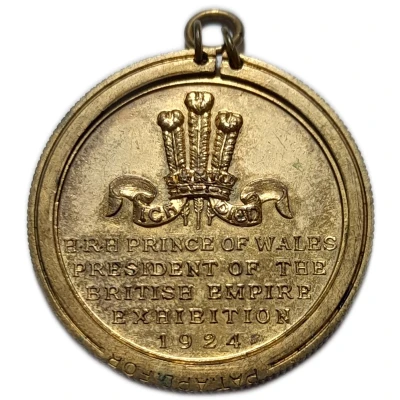


Medal - British Empire Exhibition
1924 year| Bronze (Also in Gilt Bronze) | 9.23 g | 27.49 mm |
| Location | United Kingdom (United Kingdom, British Overseas Territories and Crown Dependencies) |
|---|---|
| King | George V (1910-1936) |
| Type | Commemorative medals › Exhibition, fair and festival medals |
| Year | 1924 |
| Composition | Bronze (Also in Gilt Bronze) |
| Weight | 9.23 g |
| Diameter | 27.49 mm |
| Thickness | 1.95 mm |
| Shape | Round |
| Technique | Milled |
| Orientation | Medal alignment ↑↑ |
| Updated | 2024-11-14 |
| Numista | N#65272 |
|---|---|
| Rarity index | 88% |
Reverse
Heavy industry with ships in the foreground
Script: Latin
Lettering:
INDUSTRY
COMMERCE
(Right lower field) PM
Engraver: Percy Metcalfe
Edge
Plain
Comment
The British Empire Exhibition was a colonial exhibition held at Wembley, Middlesex in 1924 and 1925.[1][2][3][4] A highlight was the elaborate "Pageant of Empire" with thousands of actors.
It was opened by King George V on St George's Day, 23 April 1924. The British Empire contained 58 countries at that time, and only Gambia and Gibraltar did not take part. It cost £12 million and was the largest exhibition ever staged anywhere in the world - it attracted 27 million visitors.
Its official aim was "to stimulate trade, strengthen bonds that bind mother Country to her Sister States and Daughters, to bring into closer contact the one with each other, to enable all who owe allegiance to the British flag to meet on common ground and learn to know each other". Maxwell Ayrton was the architect for the project. The three main buildings were the Palaces of Industry, Engineering and Arts. The Palace of Engineering was the world's largest reinforced concrete building, a building method that allowed quick construction.
A special railway loop line and station were built, to connect the site to London Marylebone station.[8] The various buildings of the site were linked by several 'light railways', including the screw-driven 'Never-Stop Railway'.
Wikipedia
Also struck in Gilt Bronze



